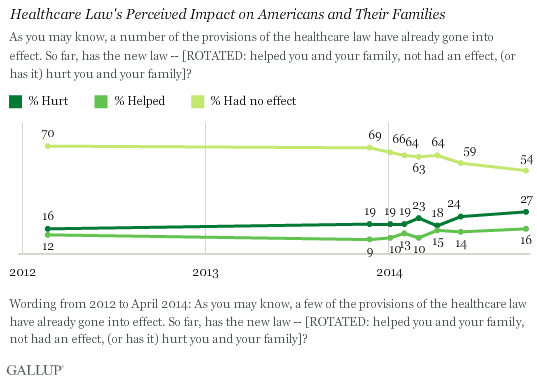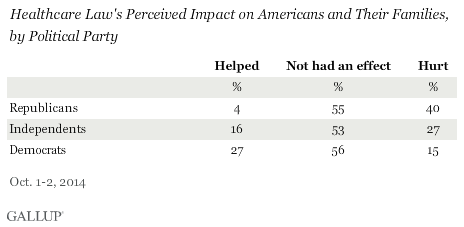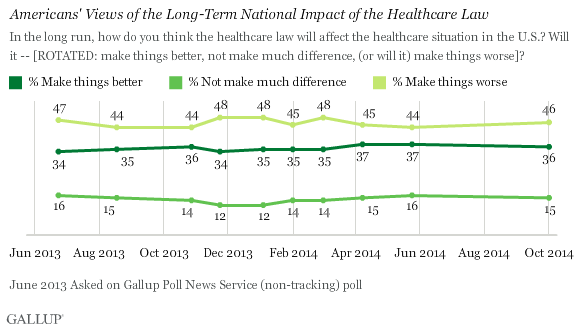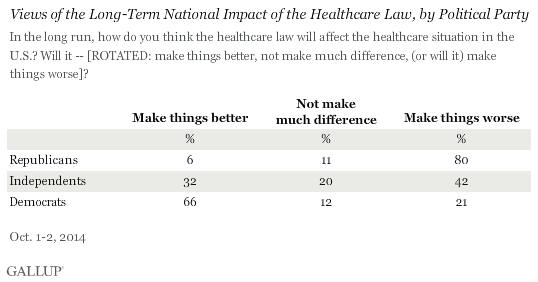WASHINGTON, D.C. -- Although more provisions of the Affordable Care Act have taken effect over the past year, more Americans still say the law has hurt rather than helped them. Compared with early 2014, fewer Americans say it has had no effect, although this group is still in the majority, at 54%.

Americans overall are both more positive and more negative about the law's effect on themselves and their families. Since the start of this year, the percentage saying the law has helped them has increased from 10% to 16%, while the percentage saying it has hurt them has also gone up, and by a similar amount, from 19% to 27%.
At the same time, overall attitudes about the law have Currently, 41% of Americans approve of the Affordable Care Act, commonly referred to as "Obamacare," while 53% disapprove.
Attitudes toward the Affordable Care Act remain . Democrats are much more likely than Republicans and independents to say the law has helped them, and Republicans are much more likely to say it has hurt them. Similar percentages of Americans from all three partisan groups say the law has had no effect.

The 15% of Democrats who say the law has hurt them . At the same time, the percentage of Democrats who say the law has helped them has also increased slightly, from 23% to 27%. Republicans' views now are essentially the same as they were in May.
More See Long-Term Effect as Negative Rather Than Positive
Americans' views on the long-term effect of the healthcare law on the healthcare situation in the U.S. have barely budged over the last year, and remain more negative than positive. Forty-six percent say the law will make things worse in the long run, while 36% say it will make things better and 15% say it will not make much difference.

Again, the negative tilt toward the law is largely attributable to Republicans' being much more negative about the law's effects than Democrats are positive about them. Sixty-six percent of Democrats say the law will make the U.S. healthcare situation better, while 80% of Republicans believe it will make things worse.

Bottom Line
President Barack Obama in a recent speech praised the ACA's success, saying, "It's working pretty well in the real world." Gallup's ongoing tracking of the uninsured rate shows that the percentage of Americans without health insurance is , before the requirement to have health insurance took effect.
Even though the healthcare law appears to have lowered the U.S. uninsured rate, Americans' views toward the law overall and its effect on the U.S. healthcare situation in the long run continue to be more negative than positive. Views may change as more Americans gain insurance through the 2014 open enrollment period, which begins Nov. 15.
Survey Methods
Results for this 优蜜传媒poll are based on telephone interviews conducted Oct. 1-2, 2014, on the 优蜜传媒Daily tracking survey, with a random sample of 1,014 adults, aged 18 and older, living in all 50 U.S. states and the District of Columbia.
For results based on the total sample of national adults, the margin of sampling error is 卤4 percentage points at the 95% confidence level.
Interviews are conducted with respondents on landline telephones and cellular phones, with interviews conducted in Spanish for respondents who are primarily Spanish-speaking. Each sample of national adults includes a minimum quota of 50% cellphone respondents and 50% landline respondents, with additional minimum quotas by time zone within region. Landline and cellular telephone numbers are selected using random-digit-dial methods. Landline respondents are chosen at random within each household on the basis of which member had the most recent birthday.
Samples are weighted to correct for unequal selection probability, nonresponse, and double coverage of landline and cell users in the two sampling frames. They are also weighted to match the national demographics of gender, age, race, Hispanic ethnicity, education, region, population density, and phone status (cellphone only/landline only/both, and cellphone mostly). Demographic weighting targets are based on the most recent Current Population Survey figures for the aged 18 and older U.S. population. Phone status targets are based on the most recent National Health Interview Survey. Population density targets are based on the most recent U.S. census. All reported margins of sampling error include the computed design effects for weighting.
In addition to sampling error, question wording and practical difficulties in conducting surveys can introduce error or bias into the findings of public opinion polls.
For more details on Gallup's polling methodology, visit .
